The global ammonium humate industry is forecast to expand from USD 131.3 million to USD 178.2 million, representing an absolute increase of USD 46.9 million during the horizon ending 2035. This expansion translates into a compound annual growth rate of 3.1%, which signals steady but not explosive growth compared with other agricultural inputs. The overall increase results in a market that is 1.36 times larger at the conclusion of the cycle ending 2035, highlighting the product’s niche yet stable role within soil conditioners and agricultural nutrient enhancers.
The first half of the cycle contributes USD 21.5 million of new value, as the industry grows from USD 131.3 million to USD 152.8 million during the phase ending 2030. This portion accounts for 46% of the decade’s increase, demonstrating that early adoption plays a critical role in setting the base. Uptake of high-concentration ammonium humate formulations, with their water retention and chelation benefits, is likely to drive this growth. Since farmers are under constant pressure to improve yields without proportionally increasing fertilizer costs, these properties make ammonium humate a compelling choice in the years leading up to 2030.
The second half of the forecast period is stronger in absolute terms, adding USD 25.4 million as the industry moves from USD 152.8 million to USD 178.2 million during the phase ending 2035. This contribution equals 54% of total expansion, showing a gradual shift toward mass market penetration. By this stage, integration with crop nutrition platforms and compatibility with irrigation infrastructure become essential factors. Ammonium humate is expected to be positioned not only as a soil conditioner but as part of bundled solutions involving biofertilizers and micronutrient packages. This broader adoption across large-scale field crops, horticulture, and specialty agriculture explains the slightly higher weight of the latter half ending 2035.
Data distribution across the two halves reveals a stable CAGR of 3.1% throughout, which underscores the consistency of this segment. Unlike high-volatility agricultural input categories, ammonium humate benefits from steady replacement cycles and the absence of sudden demand surges. The even progression suggests that industry participants can plan capacity, distribution, and partnerships with predictability, knowing that growth is gradual but durable. The long-term opportunity lies in cost efficiency and regional adoption patterns, particularly in greenhouse farming, turf management, and organic systems, where humic compounds are already valued.
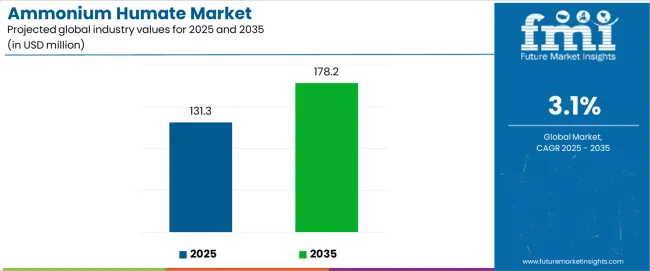
The ammonium humate market demonstrates distinct growth phases with varying market characteristics and competitive dynamics. Between 2025 and 2030, the ammonium humate market progresses through its advanced formulation adoption phase, expanding from USD 131.3 million to USD 152.8 million with steady annual increments averaging 3.1% growth. This period showcases the transition from basic humic compounds to advanced multi-grade systems with enhanced chelation properties and integrated nutrient release becoming mainstream features.
The 2025 to 2030 phase adds USD 21.5 million to market value, representing 46% of total decade expansion. Market maturation factors include standardization of concentration specifications, declining production costs for high-purity formulations, and increasing farmer awareness of premium humate benefits reaching 65-70% effectiveness in crop yield enhancement applications. Competitive landscape evolution during this period features established manufacturers like Humic Growth Solutions and Humintech expanding their product portfolios while new entrants focus on specialized organic-compliant solutions and enhanced soil conditioning technology.
From 2030 to 2035, market dynamics shift toward advanced customization and multi-crop deployment, with growth accelerating from USD 152.8 million to USD 178.2 million, adding USD 25.4 million or 54% of total expansion. This phase transition logic centers on universal high-performance systems, integration with precision agriculture equipment, and deployment across diverse cropping scenarios, becoming standard rather than specialized soil enhancement formats. The competitive environment matures with focus shifting from basic concentration to comprehensive nutrient efficiency and compatibility with modern farming operations.
At-a-Glance Metrics
| Metric | Value |
|---|---|
| $ Market Value (2025) | USD 131.3 million |
| $ Market Forecast (2035) | USD 178.2 million |
| # Growth Rate | 3.1% CAGR |
| Leading Form Type | Powder |
| Primary Application | Field Crop Segment |
The ammonium humate market demonstrates strong fundamentals with powder formulations capturing a dominant share through superior dissolution characteristics and cost-effective application capabilities. Field crop applications drive primary demand, supported by increasing agricultural productivity requirements and enhanced nutrient management solutions. Geographic expansion remains concentrated in developed agricultural markets with established farming infrastructure, while emerging economies show accelerating adoption rates driven by crop intensification projects and rising farmer awareness activity.
The ammonium humate market represents a compelling intersection of agricultural innovation, soil science advancement, and crop nutrition optimization management. With robust growth projected from USD 131.3 million in 2025 to USD 178.2 million by 2035 at a 3.10% CAGR, this market is driven by increasing agricultural intensification trends, organic farming requirements, and grower demand for reliable soil enhancement formats.
The ammonium humate market's expansion reflects a fundamental shift in how agricultural producers and specialty crop growers approach soil nutrient management infrastructure. Strong growth opportunities exist across diverse applications, from field crop operations requiring comprehensive soil conditioning to horticultural facilities demanding specialized formulations. Geographic expansion is particularly pronounced in Asia-Pacific markets, led by China (4.2% CAGR) and India (3.9% CAGR), while established markets in North America and Europe drive innovation and specialized segment development.
The dominance of powder systems and field crop applications underscores the importance of proven formulation technology and structural reliability in driving adoption. Concentration levels and manufacturing complexity remain key challenges, creating opportunities for companies that can deliver consistent performance while maintaining cost efficiency.
Market expansion rests on three fundamental shifts driving adoption across agricultural and horticultural sectors. Agricultural intensification creates compelling advantages through ammonium humate systems that provide comprehensive soil enhancement with improved nutrient availability, enabling farmers to achieve higher yields and maintain soil health while ensuring efficient fertilizer utilization and justifying investment over basic soil amendment methods. Organic farming modernization accelerates as producers worldwide seek natural soil conditioners that deliver enhanced crop performance directly to agricultural operations, enabling yield optimization that aligns with organic certification requirements and maximizes nutrient use efficiency. Crop quality improvement drives adoption from agricultural producers requiring effective soil amendments that maximize nutrient uptake while maintaining soil structure during intensive cultivation operations.
However, growth faces headwinds from raw material price variations that differ across humic acid suppliers regarding cost stability and supply chain reliability, potentially limiting margin consistency in price-sensitive agricultural categories. Regulatory compliance also persists regarding organic certification standards and application restrictions that may increase complexity standards in markets with demanding agricultural protocols.
Primary Classification: The ammonium humate market segments by form type into powder, granule, liquid, and soluble crystal categories, representing the evolution from basic humic compounds to advanced multi-grade formats for comprehensive soil conditioning operations.
Secondary Breakdown: Application segmentation divides the ammonium humate market into field crops, cash crops, horticulture, turf management, organic farming, and specialty agriculture sectors, reflecting distinct requirements for concentration levels, application methods, and nutrient enhancement performance.
Regional Classification: Geographic distribution covers Asia Pacific, North America, Europe, Latin America, and the Middle East & Africa, with developed agricultural markets leading innovation while emerging economies show accelerating growth patterns driven by agricultural modernization programs.
The segmentation structure reveals technology progression from standard powder formulations toward integrated multi-grade platforms with enhanced bioavailability and chelation capabilities, while application diversity spans from field crop operations to horticultural facilities requiring comprehensive nutrient management and soil enhancement solutions.
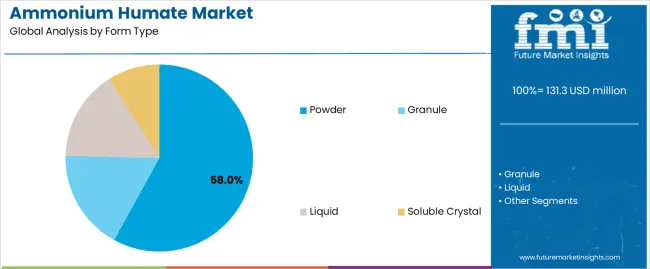
Powder segment is estimated to account for 58% of the ammonium humate market share in 2025. The segment's leading position stems from its fundamental role as a critical component in soil amendment applications and its extensive use across multiple agricultural and horticultural sectors. Powder's dominance is attributed to its superior dissolution characteristics, including excellent water solubility, uniform distribution properties, and balanced cost-effectiveness that make it indispensable for everyday crop nutrition operations.
Market Position: Powder systems command the leading position in the ammonium humate market through advanced processing technologies, including comprehensive particle size control, uniform composition distribution, and reliable manufacturing performance that enable producers to deploy soil enhancement solutions across diverse agricultural environments.
Value Drivers: The segment benefits from farmer preference for proven formulation profiles that provide exceptional nutrient availability without requiring premium application costs. Efficient processing methods enable deployment in field crop applications, greenhouse operations, and organic farming systems where dissolution reliability and cost efficiency represent critical selection requirements.
Competitive Advantages: Powder systems differentiate through excellent mixing capabilities, proven nutrient release, and compatibility with standard application equipment that enhance soil conditioning capabilities while maintaining economical material profiles suitable for diverse agricultural applications.
Key market characteristics:
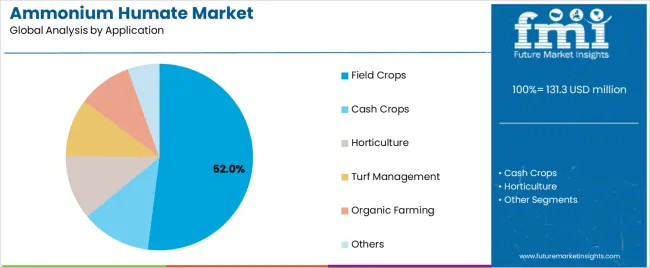
Field crop segment is projected to hold 52% of the ammonium humate market share in 2025. The segment's market leadership is driven by the extensive use of ammonium humate in grain production, row crop cultivation, cereal farming, and broadacre agriculture, where humic compounds serve as both a soil conditioner and nutrient efficiency enhancer. The field crop sector's consistent demand for reliable soil amendments supports the segment's dominant position.
Market Context: Field crop applications dominate the ammonium humate market due to widespread adoption of yield enhancement solutions and increasing focus on soil health improvement, nutrient uptake optimization, and root development that enhance agricultural productivity while maintaining soil structure.
Appeal Factors: Agricultural producers prioritize cost-effectiveness, proven performance, and integration with existing fertilization systems that enable coordinated deployment across multiple cropping needs. The segment benefits from substantial acreage expansion and crop intensification that emphasize reliable soil enhancement systems for grain and row crop applications.
Growth Drivers: Agricultural extension programs incorporate ammonium humate as standard components for soil improvement and crop nutrition programs. At the same time, farmer education initiatives are increasing demand for performance features that comply with agronomic best practices and enhance crop yield potential.
Market Challenges: Raw material cost fluctuations and application rate standardization may limit deployment flexibility in ultra-price-sensitive markets or regions with varying soil conditions.
Application dynamics include:
Growth Accelerators: Agricultural intensification drives primary adoption as ammonium humate systems provide exceptional soil enhancement capabilities that enable crop production without nutrient deficiency, supporting yield improvement and agricultural efficiency that require reliable humic compounds. Organic farming growth accelerates market expansion as producers seek natural soil conditioners that maintain crop quality during cultivation while enhancing nutrient availability through improved chelation and compatibility. Farmer awareness increases worldwide, creating demand for proven soil amendment systems that complement modern agriculture and provide operational advantages in nutrient management efficiency.
Growth Inhibitors: Raw material volatility challenges differ across humic acid markets regarding price stability and supply chain consistency, which may limit margin predictability and cost planning in price-sensitive agricultural categories with demanding affordability requirements. Regulatory complexity persists regarding organic certification standards and application restrictions that may increase compliance costs in jurisdictions with strict agricultural protocols. Market fragmentation across multiple concentration specifications and application methods creates compatibility concerns between different farming systems and existing nutrient management infrastructure.
Market Evolution Patterns: Adoption accelerates in agricultural and horticultural sectors where yield benefits justify material investments, with geographic concentration in developed markets transitioning toward mainstream adoption in emerging economies driven by agricultural modernization and crop intensification development. Technology advancement focuses on enhanced bioavailability, improved manufacturing efficiency, and integration with precision application systems that optimize soil conditioning performance and nutrient consistency. The ammonium humate market could face disruption if alternative soil enhancement methods or regulatory changes significantly challenge traditional ammonium humate advantages in agricultural applications.
The ammonium humate market demonstrates varied regional dynamics with growth leaders including China (4.2% CAGR) and India (3.9% CAGR) driving expansion through agricultural modernization and crop intensification programs. Steady Performers encompass Germany (3.6% CAGR), Brazil (3.3% CAGR), and the U.S. (2.9% CAGR), benefiting from established agricultural systems and precision farming adoption.
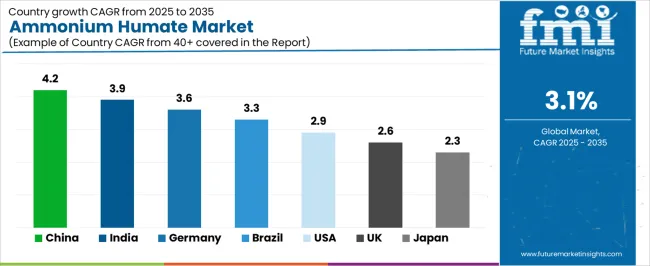
| Country | CAGR (2025-2035) |
|---|---|
| China | 4.2% |
| India | 3.9% |
| Germany | 3.6% |
| Brazil | 3.3% |
| USA | 2.9% |
| UK | 2.6% |
| Japan | 2.3% |
Regional synthesis reveals Asia-Pacific markets leading growth through agricultural intensification and soil health awareness development, while European countries maintain steady expansion supported by organic farming applications and environmental compliance requirements. North American markets show moderate growth driven by precision agriculture demand and specialty crop facility upgrades.
China establishes regional leadership through comprehensive agricultural modernization and extensive crop production intensification, integrating advanced ammonium humate systems as standard components in soil enhancement and crop nutrition operations. The country's 4.2% CAGR through 2035 reflects agricultural expansion promoting intensive farming and domestic food security development that mandate the use of reliable soil conditioning systems in crop production operations. Growth concentrates in major agricultural regions, including Shandong, Henan, and Jiangsu provinces, where farming cooperatives showcase integrated ammonium humate systems that appeal to agricultural authorities seeking enhanced crop yields and international farming standards.
Chinese manufacturers are developing innovative ammonium humate solutions that combine local production advantages with international quality specifications, including multi-grade formulations and advanced chelation capabilities.
Strategic Market Indicators:
The Indian market emphasizes agricultural applications, including rapid farming modernization and comprehensive crop intensification that increasingly incorporates ammonium humate for soil improvement and nutrient efficiency applications. The country is projected to show a 3.9% CAGR through 2035, driven by massive agricultural development activity under food security initiatives and farmer demand for cost-effective, high-quality soil enhancement systems. Indian agricultural operations prioritize yield improvement with ammonium humate delivering crop performance through economical material usage and reliable nutrient availability capabilities.
Technology deployment channels include major agricultural states, farming cooperatives, and agricultural input dealers that support high-volume usage for grain and cash crop applications.
Performance Metrics:
The German market emphasizes advanced ammonium humate applications, including innovative soil science technologies and integration with comprehensive crop nutrition platforms that manage field crop production, specialty agriculture, and organic farming through unified soil enhancement systems. The country is projected to show a 3.6% CAGR through 2035, driven by precision agriculture expansion under environmental stewardship trends and farmer demand for premium, reliable soil conditioning systems. German agricultural operations prioritize soil health with ammonium humate delivering comprehensive nutrient management through enhanced bioavailability and operational innovation.
Technology deployment channels include major agricultural regions, crop consulting services, and specialty input suppliers that support custom development for precision operations.
Performance Metrics:
In Mato Grosso, São Paulo, and Rio Grande do Sul, Brazilian agricultural operations and farming enterprises are implementing advanced ammonium humate systems to enhance crop capabilities and support operational efficiency that aligns with agricultural protocols and production standards. The Brazilian market demonstrates sustained growth with a 3.3% CAGR through 2035, driven by agricultural expansion programs and farming investments that emphasize reliable soil enhancement systems for grain and cash crop applications. Brazilian agricultural facilities are prioritizing ammonium humate systems that provide exceptional nutrient efficiency while maintaining compliance with agricultural standards and minimizing input complexity, particularly important in large-scale farming and export crop operations.
Market expansion benefits from agricultural development programs that mandate enhanced soil conditioning in crop specifications, creating demand across Brazil's grain and specialty crop sectors, where yield optimization and soil health represent critical requirements.
Strategic Market Indicators:
The USA market emphasizes advanced ammonium humate features, including innovative formulation technologies and integration with comprehensive precision agriculture platforms that manage crop nutrition, soil health monitoring, and specialty agriculture through unified soil conditioning systems. The country is projected to show a 2.9% CAGR through 2035, driven by precision farming expansion under agricultural technology trends and producer demand for premium, reliable soil enhancement systems. American agricultural operations prioritize operational efficiency with ammonium humate delivering comprehensive crop nutrition through enhanced chelation properties and technological innovation.
Technology deployment channels include major agricultural regions, crop consultants, and specialty distributors that support custom development for precision operations.
Performance Metrics:
The UK market demonstrates sophisticated ammonium humate deployment, growing at 2.6% CAGR, with documented operational excellence in crop nutrition and specialty agriculture through integration with existing soil management systems and quality assurance infrastructure. The country leverages agricultural expertise in crop science and soil chemistry to maintain market leadership. Agricultural regions, including East Anglia, Yorkshire, and the Midlands, showcase advanced installations where ammonium humate systems integrate with comprehensive crop nutrition platforms and soil testing systems to optimize agricultural productivity and operational efficiency.
British agricultural operations prioritize soil health precision and nutrient consistency in product selection, creating demand for premium ammonium humate systems with advanced features, including enhanced bioavailability and integration with precision application protocols. The ammonium humate market benefits from established agricultural infrastructure and willingness to invest in specialized soil enhancement technologies that provide superior crop performance and regulatory compliance.
Market Intelligence Brief:
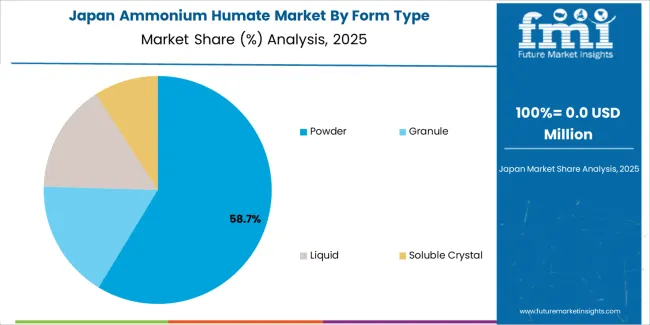
Japan's sophisticated agricultural market demonstrates meticulous ammonium humate deployment, growing at 2.3% CAGR, with documented operational excellence in crop nutrition and specialty agriculture through integration with existing precision farming systems and quality control infrastructure. The country leverages technological expertise in agricultural science and soil management to maintain market leadership. Agricultural prefectures, including Hokkaido, Aichi, and Kagoshima, showcase advanced installations where ammonium humate systems integrate with comprehensive crop nutrition platforms and soil monitoring systems to optimize agricultural productivity and operational efficiency.
Japanese agricultural operations prioritize soil enhancement precision and nutrient consistency in product selection, creating demand for premium ammonium humate systems with advanced features, including ultra-pure formulations and integration with automated application protocols. The ammonium humate market benefits from established agricultural infrastructure and willingness to invest in specialized soil conditioning technologies that provide superior crop performance and regulatory compliance.
Market Intelligence Brief:
The ammonium humate market in Europe is projected to grow from USD 38.4 million in 2025 to USD 53.7 million by 2035, registering a CAGR of 3.4% over the forecast period. Germany is expected to maintain its leadership position with a 42.8% market share in 2025, declining slightly to 42.2% by 2035, supported by its agricultural excellence and major farming centers, including Bavaria and Lower Saxony.
France follows with a 21.6% share in 2025, projected to reach 22.1% by 2035, driven by comprehensive agricultural programs and specialty crop initiatives. The United Kingdom holds a 16.4% share in 2025, expected to maintain 16.8% by 2035 through established agricultural sectors and organic farming adoption. Italy commands a 11.2% share, while Spain accounts for 6.8% in 2025. The Rest of Europe region is anticipated to gain momentum, expanding its collective share from 1.2% to 1.6% by 2035, attributed to increasing agricultural development in Eastern European countries and emerging organic farming programs implementing advanced soil enhancement systems.
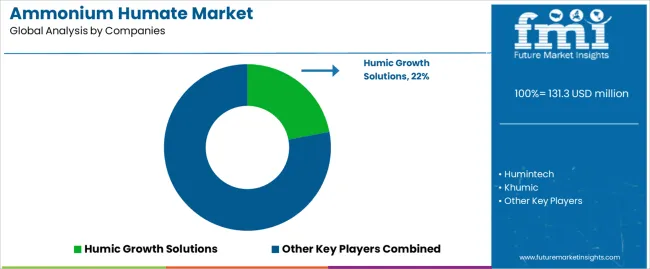
The ammonium humate market operates with moderate concentration, featuring approximately 15-22 participants, where leading companies control roughly 38-44% of the global market share through established distribution networks and comprehensive product portfolio capabilities. Competition emphasizes concentration purity, manufacturing consistency, and cost efficiency rather than premium feature rivalry.
Market leaders encompass Humic Growth Solutions, Humintech, and Khumic, which maintain competitive advantages through extensive humic acid processing expertise, global distribution networks, and comprehensive technical support capabilities that create agricultural dealer loyalty and support farmer requirements. These companies leverage decades of soil science experience and ongoing formulation technology investments to develop advanced ammonium humate systems with exceptional bioavailability and chelation features.
Specialty challengers include Saint Humic Acid, Jingfeng Humic Acid Technology, and Xinjiang Shengdayifang Biotechnology, which compete through specialized application innovation focus and efficient manufacturing solutions that appeal to agricultural buyers seeking reliable performance formats and custom formulation flexibility. These companies differentiate through operational efficiency emphasis and specialized market focus.
Market dynamics favor participants that combine consistent nutrient performance with advanced manufacturing support, including bulk packaging and distribution capabilities. Competitive pressure intensifies as traditional fertilizer manufacturers expand into ammonium humate systems. At the same time, specialized soil amendment producers challenge established players through innovative processing methods and cost-effective production targeting emerging agricultural segments.
| Item | Value |
|---|---|
| Quantitative Units | USD 131.3 million |
| Form Type | Powder, Granule, Liquid, Soluble Crystal |
| Application | Field Crops, Cash Crops, Horticulture, Turf Management, Organic Farming, Others |
| Regions Covered | Asia Pacific, North America, Europe, Latin America, Middle East & Africa |
| Countries Covered | China, India, Germany, Brazil, U.S., U.K., Japan, and 25+ additional countries |
| Key Companies Profiled | Humic Growth Solutions, Humintech, Khumic, Saint Humic Acid, Jingfeng Humic Acid Technology, Xinjiang Shengdayifang Biotechnology |
| Additional Attributes | Dollar sales by form type and application categories, regional adoption trends across Asia Pacific, North America, and Europe, competitive landscape with humic acid processors and agricultural input manufacturers, farmer preferences for concentration levels and application methods, integration with fertilization equipment and irrigation systems, innovations in processing technology and multi-grade systems, and development of specialized formulations with enhanced bioavailability and chelation properties |
The global ammonium humate market is estimated to be valued at USD 131.3 million in 2025.
The market size for the ammonium humate market is projected to reach USD 178.2 million by 2035.
The ammonium humate market is expected to grow at a 3.1% CAGR between 2025 and 2035.
The key product types in ammonium humate market are powder, granule, liquid and soluble crystal.
In terms of application, field crops segment to command 52.0% share in the ammonium humate market in 2025.






Full Research Suite comprises of:
Market outlook & trends analysis
Interviews & case studies
Strategic recommendations
Vendor profiles & capabilities analysis
5-year forecasts
8 regions and 60+ country-level data splits
Market segment data splits
12 months of continuous data updates
DELIVERED AS:
PDF EXCEL ONLINE
Ammonium Dichromate Market Size and Share Forecast Outlook 2025 to 2035
Ammonium Nitrate Market Size and Share Forecast Outlook 2025 to 2035
Ammonium Metavanadate Market Size and Share Forecast Outlook 2025 to 2035
Ammonium Thiosulfate Market – Size, Share, and Forecast 2025 to 2035
Ammonium Sulphate Supply Market-Trends & Forecast 2025 to 2035
Ammonium Sulfate Food Grade Market Report - Industry Insights 2025 to 2035
Ammonium Chloride Food Grade Market Growth - Demand & Trends 2025 to 2035
Ammonium Carbonate Market Growth 2024-2034
Ammonium Phosphate Market Trends & Analysis 2019-2029
Ammonium Phosphatides Market
Diammonium Hydrogen Phosphate Market Size and Share Forecast Outlook 2025 to 2035
Diammonium Phosphate Market
Triammonium Citrate Market Size and Share Forecast Outlook 2025 to 2035
Calcium Ammonium Nitrate Market Growth - Trends & Forecast 2025 to 2035
Aluminium Ammonium Sulphate Market Analysis – Size, Share, and Forecast Outlook 2025 to 2035
Food Grade Ammonium Carbonate Market Growth - Product Type & Application Analysis
Food Grade Ammonium Bicarbonate Market
Quaternary Ammonium Compounds Market
High Molecular Ammonium Polyphosphate Market Size and Share Forecast Outlook 2025 to 2035
Cetyl Trimethyl Ammonium Chloride Market

Thank you!
You will receive an email from our Business Development Manager. Please be sure to check your SPAM/JUNK folder too.
Chat With
MaRIA